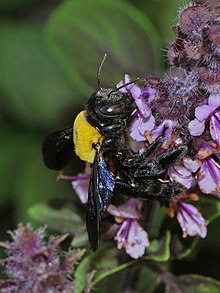| Xylocopa pubescens | |
|---|---|

| |
| Female | |
| Scientific classification | |
| Domain: | Eukaryota |
| Kingdom: | Animalia |
| Phylum: | Arthropoda |
| Class: | Insecta |
| Order: | Hymenoptera |
| Family: | Apidae |
| Genus: | Xylocopa |
| Species: | X. pubescens
|
| Binomial name | |
| Xylocopa pubescens Spinola, 1838
| |
| Synonyms[1] | |
| |
Xylocopa pubescens is a species of large carpenter bee. Females form nests by excavation with their mandibles, often in dead or soft wood. X. pubescens is commonly found in areas extending from India to Northeast and West Africa. It must reside in these warm climates because it requires a minimum ambient temperature of 18 °C (64 °F) in order to forage.[2]
A common area of study in X. pubescens is its dominance hierarchy and guarding behavior. Colonies start and end with female takeover, either by daughters of the dominant female or by foreign intruders. There is only one reproductively active female in a colony at a time who suppresses the reproduction of other females in the nest. Males hold individual territories which females enter to mate. When an intruder enters another male's territory, the male responds aggressively.[3]
X. pubescens is polylectic, so it forages on many species of plants. It forages on some plants for nectar when preparing bee bread during ontogenesis and forages on others for pollen to feed offspring. Pheromones from Dufour's gland are vital to mark flowers previously visited and also to mark nests so that the foraging bees know where to return.[4] X. pubescens is known to be an effective pollinator, often more effective than honeybees, but it is not commonly used in today's agricultural settings.[5]
- ^ "Xylocopa pubescens". Global Biodiversity Information Facility. Retrieved 2024-08-06.
- ^ Gerling, Dan; Hurd, Paul David; Hefetz, Abraham (1982). "Comparative behavioral biology of two Middle East species of carpenter bees (Xylocopa Latreille) (Hymenoptera:Apoidea)". Smithsonian Contributions to Zoology (369): 1–33. doi:10.5479/si.00810282.369. ISSN 0081-0282. S2CID 9579784.
- ^ Hogendoorn, Katja; Velthuis, Hayo H.W. (April 1993). "The sociality of Xylocopa pubescens: does a helper really help?". Behavioral Ecology and Sociobiology. 32 (4): 247–257. doi:10.1007/bf00166514. S2CID 42775086.
- ^ Cite error: The named reference
bionomicswas invoked but never defined (see the help page). - ^ Cite error: The named reference
:0was invoked but never defined (see the help page).